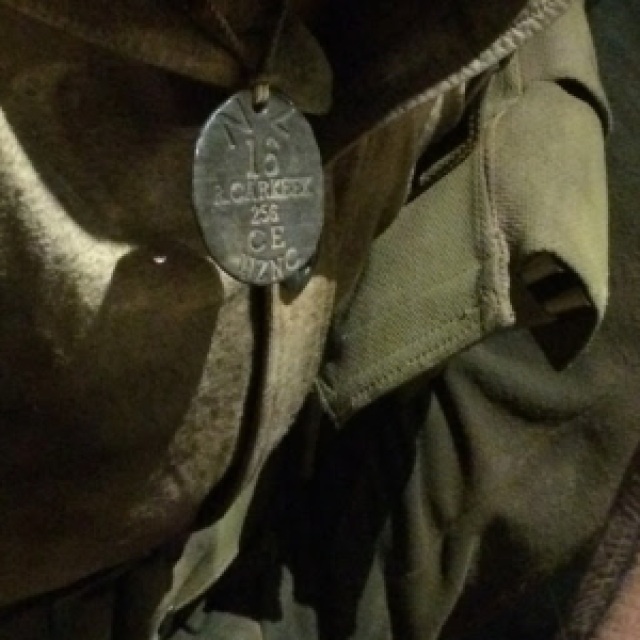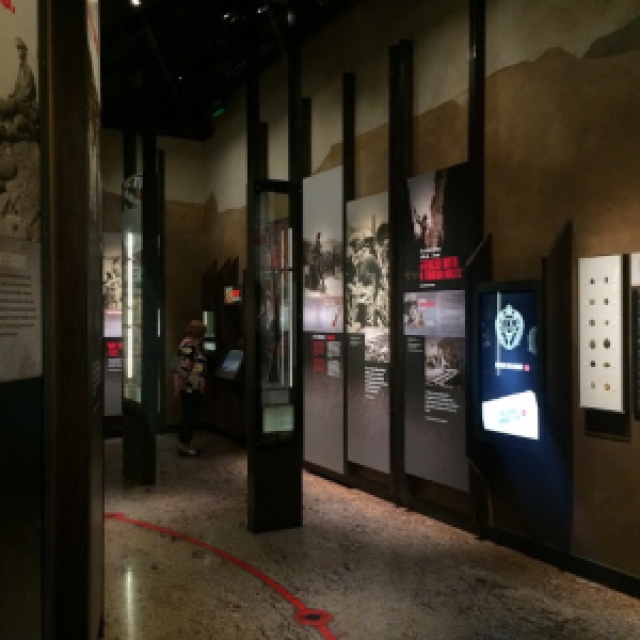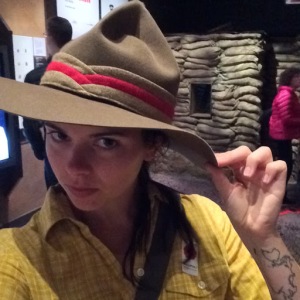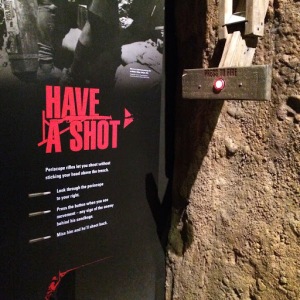I promised a part three of my posts on Te Papa, and here you go. When Bryn heard that I had had a rather “full” tour of the Gallipoli exhibit, he asked me if I wanted to come back to do the early bird tour. The idea behind this is that, because the exhibit is so crowded from ten am onward, some people will pay for an exclusive, private-with-forty-other-people tour before the museum opens. For my review of the exhibit as a regular guest, please click here. It will give you more background on the exhibition itself.
When I arrived at 9:20, the lobby was already teeming with people, awaiting the museum opening at ten. I stopped into the shop and picked up a small sticker denoting my early bird status. In the ground floor foyer, guides were milling around, making sure no one went upstairs and otherwise directing traffic. Only about twelve of us had the Gallipoli stickers on but the early bird tours can be as many as forty people.
At about 9:25, an older man gathered those of us with stickers, introduced himself as Bruce, and led us upstairs. We passed the information desk and stopped at the carpeted circle in front of the exhibit. Here, he talked with us just a little bit about the “scale of the war” – literally 2.4 times human scale (hence the larger-than-life size of the models.)
He then told us that at ten am, there would be four school groups coming in, and he ushered us into the exhibit. It was a far cry from the way I entered the exhibit two weeks ago. It was pure quiet. It wasn’t rushed. No one was bumping into me. You could wait your turn to read something because fifteen other people weren’t going to try to cut in front of you. And yet, we shared this experience together. Three of us flipped through the interactive screens, our hands brushing against each others as we alternated sliding screens.
Bruce wandered among us, offering little bits of information not written anywhere. I learned more about Gallipoli having him as a guide than I did exploring the exhibit on my own. For instance, there’s a path that winds through the exhibit, marking dates and places. It also has numerous crosses along the path. I didn’t know that the crosses that mark the ground indicate the number of dead each day. It makes the path all that more poignant.
What I really enjoyed about this experience was the calm atmosphere. I felt that if I wanted to interact with another visitor, I could do so but I wasn’t forced to share any displays with anyone or fight for space. We were scattered through the exhibit and everyone went at their own pace.
At 9:55 I was at the near end of the trench, near William Malone’s dugout tent. He made a home out of it, building a bed and a desk from ammunition crates. Down the long hallway, through the trench, was the rest of the exhibition: the Maori element, the Chunuk Bair campaign, saying goodbye, and the rest of the war. To get there, I had to walk through the trench. Lights flashed, guns fired, and if I looked into the gaps in the wall, a soldier might run at me. Somewhat eerie, but a good interpretation of what these soldiers went through. Bruce had a group around him here, where he was talking about the rum rations: “the soldiers got one rum ration each day, but of late it had been sporadic. All of a sudden, they were getting two rum rations a day. They all knew something was going on, but they didn’t know what.” It was Chunuk Bair.
Bruce checked his watch and gave us the five minute warning, “in five minutes, four school groups are going to come through.” We all kind of giggled but I sensed a little bit of apprehension in my fellow tour-goers: we’d had this incredible experience to ourselves and now we had to share it. Several of us set off through the trench. We rounded the corner into the Chunuk Bair and Maori exhibit.
I moved on, to see Lottie le Gallais grieving for her brother. As she spoke of never being able to see him again, or to sit at his grave and lay flowers for him, I could feel her pain. To have had to go months thinking your brother is alive and well, albeit in a warzone, only to learn via letters marked “return to sender” that he is dead, well, that’s a pain no one wants to experience. Her voice cracked as she spoke of him and of turning away to watch the rolling seas.
Here, I checked the time: 10:05. That meant that there were schoolchildren in the exhibit, but I couldn’t hear them. My group and I were utterly alone at the end of the exhibit.
I wound my way toward the exit, stopping to write a little note. As I circled down past Cecil Malthus kneeling in a sea of poppies, I tossed mine in, another remembrance in a pool of red tears.
When I exited, at 10 past 10am, the line was outrageous. It wound across the foyer on the first level, people waiting their turn to glimpse the popular exhibition. If I could offer one recommendation for visitors, it would be to pay the $10 for an early bird tour. I was blown away by the efficiency of the tour and the attention that was paid to the guests.
My many thanks to Bryn for arranging the tour!
To book a tour at Te Papa, click here. For the Te Papa website on the Gallipoli exhibit, click here. All rectangular images are courtesy of Te Papa.
Like this post? Pin it!


















